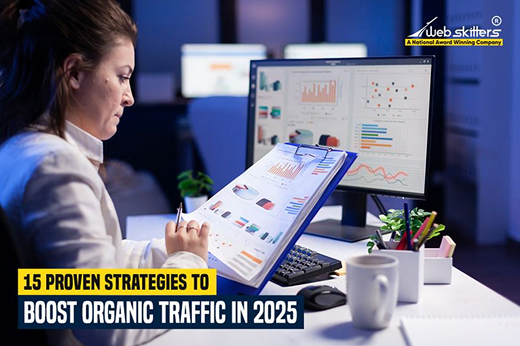Who does not enjoy their digital storefront’s skyrocketing organic traffic? Increasing user footfall, more conversions and sales, and increased revenue are dreams coming true for online business owners.
However, the ideal digital results demand the perfect strategies. Today, we are here to discuss some proven tricks to boost organic traffic through search Engine Optimization.
As an SEO agency in London, we have had the privilege of acting as growth hackers for several businesses. Search engine optimization works regardless of your business niche or years in the market. While it can be a long-term approach, SEO is the most concrete method for boosting sales, increasing ROI, and effortlessly engaging traffic.
Let us explore some search engine optimization techniques curated by our SEO experts. We will also analyze popular SEO trends in 2025 and how to stay ahead of the competition.
What is Search Engine Optimization? Why is it vital to boost organic traffic?
SEO entails website performance optimization strategies to ensure the presence is designed for users and search engines to find the presence relevant.
For instance, if you have an e-commerce store with numerous authentic products, you would want your target customers to find the business. Here is where search engine rankings become vital. The algorithm ranks various websites based on content relevance and web page technicalities.
Several factors are considered when ranking a website – user-friendliness, page speed, navigation, keywords, authentic content, and more.
Most soaring businesses hire a professional SEO company to ensure their presence is optimized for traffic surge. Remember, SEO is not an optional strategy for organic growth. The experts leverage proven tactics and know the trends and hacks to help a brand stay competitive.
15 SEO Strategies to Boost Organic Traffic
Numerous marketing tactics are prevalent in the market for quick and actionable results. However, search engine optimization tops the tier for its scalability and long-term approach.
Let us take a look into the proven SEO strategies that will rule the marketing domain in 2025 –
1. Focus on User Experience (UX)
Your prime objective must be the user, not the search engine. Therefore, user experience is critical. In simple terms, it is the overall browsing experience—from entering the website to the conversion moment.
Whether or not a visitor will convert into a customer depends on the UX. Businesses focusing on improving the user experience have gained 400% higher conversions. Therefore, not prioritizing user experience can prove a backlash for businesses. When done right, it leads to better engagement and elevated revenue.
Here are some actionable UX tips for user engagement improvement –
• Pay attention to website loading speed. A slow-loading web page loses 7 out of 10 visitors, leading to a decline in conversion and increased bounce rates. Google and other search engines prefer websites with quick loads and offer smooth browsing.
Several measures can ensure faster page loading: keeping the images optimized, reducing irrelevant extensions, using a CDN, optimizing the website structure, etc.
We recommend hiring a website development company to resolve the technicalities.
• Prioritize clean navigation over everything else. Your users must be able to find what they are looking for and not get confused with an intricate menu structure. Keep the menu simple, jargon-free, and effectively branched to ensure everything can be found within the presence. Use breadcrumbs to explain the website hierarchy to the search algorithms.
• Mobile optimization is crucial—no matter the business niche. 49% of online traffic comes from mobile devices. For customers, it is a convenient medium to browse, shop, pay, and more. Furthermore, Google crawls and indexes mobile-friendly websites as a priority. Therefore, make sure the website has a responsive structure and runs seamlessly on varied mobile devices.
• SEO-friendly design elements and content play a significant role in delivering organic results. The purpose of quality design and content is to engage the users and guide them toward the sales funnel. Keeping that in mind, a simplified form, interactive mega menu, or even a simplified one has much to contribute.
These are only a few UX measures to create a lasting impression on visitors and maintain an effective retention rate. SEO experts can implement several other tactics for an elevated user experience.
2. Leverage Long-Tail KeywordsWhat are long-tail keywords?
Long-tail keywords are specific words users use when not casually browsing but intended to convert. These generate have three to six words and have a targeted approach.
◦ Consider it from the user’s point of view. Say you are looking for the best pizza joint in Boston, particularly near Copley Square or the Boston Public Library. So, the ideal search term would be “best pizza near Copley Square.” You will be offered a list of pizza places on that street.
◦ Now, things can become interesting with other specifics. For example, “best pizza with anchovies” or “best pizza without cheese” are preferable search terms among many.
◦ For the business, this is the ideal opportunity to optimize the website content with these specific terms. This helps users and search engines understand that you cater to their requirements.
Why are long-tail keywords significant in 2025?
Long-tail keywords help you reach the perfect audience base, and the conversion is amazing. Additionally, with voice search, generative AI, and NLP gaining traction, long-tail keywords will become the search norm among users.
The sole purpose of using long-tail keywords is that they are not competitive or as popular as primary short-tail keywords and make ranking easier.
There are several ways to identify long-tail keywords. Google is a gold mine for popular search phrases. Besides Google, an SEO agency utilizes keyword research tools like Semrush, Google Keyword Planner, and Ahrefs.
3. Optimize for Voice Search
We mentioned that voice search is gaining traction, and given the 2025 SEO trends, voice search optimization is critical.
Voice search has changed how users browse or explore products and services. It has enhanced usability and simplified digital activities for all. 25% of the US population prefers voice search over other methods. It is simple, convenient, and relies on natural language processing.
Therefore, investing in voice search optimization is a lucrative measure for business. It helps reach a broader customer base and is modern website integration. Furthermore, the customer experience with voice search is premium. People can browse on the go; it is also a hands-free activity.
Here are some tips for voice search optimization –
• Voice search relies on long-term search queries; therefore, hiring professionals who are aware of the approach is ideal. Most voice search terms are conversational keywords people generally use.
• 55% of the users opt for voice search during local browsing. Therefore, prioritize geographical keywords for the maximum outcome.
• Content is the cornerstone of your SEO efforts. The ideal method for voice search is to use content and answer directly for the users.
4. Prioritize Mobile-First Indexing
We cannot highlight this enough – mobile-first websites are crucial, and they perform better in SEO. This is how it works in action –
Google’s web crawlers opt for the mobile versions of a web presence. The desktop version is also crawled. Therefore, the initial ranking is the mobile presence, which must be user-focused and immaculate.
The ideal is to deliver a stellar presence, which must be fast-loading, user-friendly, navigable, and content-rich to have a noticeable impact on SEO ranking.
These are the fundamentals of creating a mobile-first web presence. Here are some best practices –
• Prioritize responsiveness and ensure the presence is not only mobile-friendly but also functions smoothly across varied devices. Responsiveness ensures the structure and design adapt to the screen size without error.
• Make the presence search engine crawlable. It means there must not be any CSS or JavaScript blocker. Additionally, structured data helps search engines understand the content.
• Keep the presence in check to avoid technical faults.
5. Create High-Quality, In-Depth Content
Content is prime and highlights the search engines that the website is relevant and worth ranking. So, if authentically written with intelligible structures, content helps reach the target customers and influence them towards conversion.
Here are some actionable steps to craft rank-worthy content for your business –
• Incorporating keywords are vital; however, do not overdo the process. Place keywords naturally and ensure the content delivers authentic information. Prioritize users over Google when creating content.
• Create a hierarchy through headings, subheadings, and bullets. The algorithm prefers structured content, and you can optimize the piece for featured snippets.
• The content must resolve user issues and not just be crafted for search engine algorithms. Focus on being conversational and keeping it simple and informative for the readers.
Content quality reinforces SEO strategies and brings lucrative business growth and scalable results. Invest in quality content and be open to A/B testing to understand what works and what does not.
6. Build a Strong Backlink Profile
Backlinks are links from other websites to yours, and they indicate that other resources consider your content valuable and your presence credible. A quality backlink profile is essential for search engine algorithms to notice your presence.
Furthermore, it helps to increase your website’s traffic, and people tend to click on informative links within resources.
Here is a quick guide on how to build a sturdy Backlink profile –
• Create high-quality content relevant to your target audience. This will encourage other websites to link to your content.
• Promote your content on social media and other channel. As more people interact with your content, they are more likely to link to it.
• Contact other websites and ask them to link to your content. You can do this by email, commenting on their blog posts, or connecting with them on social media.
Talk to a professional SEO company, and they will highlight the importance of building relationships with other websites in your industry. SEO experts are adept at collaborating through guest blogs and elevating the authority of the business website.
7. Improve Site Speed
Slow websites frustrate users and lead to a higher bounce rate. A laggy web presence is your biggest mistake when planning to boost organic traffic. Additionally, Google prioritizes websites with a good user experience, including fast load times.
Furthermore, Google prioritizes mobile-first indexing, and optimizing your site’s speed on mobile devices is equally crucial.
Here are some optimization tips to discuss when hiring a professional SEO agency –
• Reduce Image Sizes – Optimize images using tools like TinyPNG or ImageOptim to reduce file size without compromising quality.
• Minify CSS and JavaScript – Use online tools to minify your CSS and JavaScript files, removing unnecessary characters and spaces.
• Leverage Browser Caching – to store static resources locally and reduce the need to download them repeatedly.
• Reduce HTTP Requests – Combine CSS and JavaScript files and minimize the number of external scripts and stylesheets.
We recommend choosing a web hosting provider with reliable servers and fast load times. Regularly testing the speed makes it effortless to monitor performance over time and make adjustments as needed.
8. Use Schema Markup
Schema markup is a technical vocabulary that helps search engines better understand website content. It provides additional information about your content, like the type (article, product, event), key details (author, date, price), and relevant keywords.
Schema markup helps search engines display more informative and visually appealing content, such as rich snippets or knowledge graphs.
Here is how to utilize Schema for content productivity –
• Choose a Schema Type: Determine the appropriate schema type for your content. Common types include Article, Product, Event, Organization, and Person.
• Identify Relevant Properties: Identify the specific properties within the schema type applicable to your content. For instance, the Article schema includes properties like headline, author, date Published, and description.
• There are multiple ways to insert the schema within the content. You can insert the schema markup into the HTML code, embed it as JSON-LD or Microdata within your HTM, or use plugins or tools like Schema App or Google Tag Assistant to automatically generate and add schema markup.
• Validate Your Markup: Use a schema validator to ensure the markup is correct and free of errors. This helps search engines understand the content accurately.
9. Leverage Video Content
Videos are highly engaging and capture attention more effectively than text-based content. Statistics highlight that users tend to spend more time on pages with video content, which contributes to the ranking structures.
Here are some tips for creating and optimizing video content for SEO –
• Identify relevant keywords and incorporate them into your video titles, descriptions, and tags. Additionally, provide a written transcript of the video to improve accessibility and help search engines understand the content.
• Create visually appealing thumbnails that entice viewers to click. Embed the videos directly on your website to improve user experience and keep viewers on your site.
• Share your videos on social media platforms to reach a wider audience. You can also leverage YouTube to reach a broader audience base.
10. Focus on Local SEO
With the rise of smartphones and location-based services, local search has become increasingly crucial for businesses. Local SEO strategies ensure a business effortlessly appears based on location-based keywords in local searches.
Here are effective strategies to optimize for local search –
• Ensure your business is listed on Google My Business and provide accurate information, including name, address, phone number, website, and business hours.
• Positive reviews significantly improve your local search ranking. Encourage customers to leave reviews on Google My Business and other platforms.
• Create citations for your business on local directories and websites. This will help search engines understand your business’s location and credibility.
• If availing of local online ads, use geo-targeting to target the content to specific geographic locations.
11. Regularly Update Content
We have discussed the vitality of content for positive SEO impact. Let’s discuss how often updating the content is critical.
Google favors websites with fresh and updated content. Regularly updating your content helps improve your search engine rankings.
Focus on providing informative and relevant content to keep the audience engaged and elevate on-site time.
Here are some tips to update content and steer clear of age-old irrelevant structures –
• Regularly audit the website to identify content that needs updating. Look for outdated information, broken links, or content that no longer aligns with the current business goals.
• When updating your content, ensure it is optimized for relevant keywords. It helps improve your search engine ranking. For time-sensitive content, set an expiration date and remove it from your website when it becomes outdated
• Share your updated social media and email list content to reach a wider audience.
12. Utilize AI and Automation in SEO
We are in the AI era; everything can be effortlessly automated with specific tools and extensions. In terms of SEO, data analysis is the perfect tool to curate ideal business strategies.
AI can analyze vast amounts of data to identify SEO trends, patterns, and opportunities. It can suggest relevant keywords and phrases based on your content and target audience. Additionally, businesses can identify potential backlink opportunities and automate outreach processes.
Here is how to utilize AI tools to boost organic traffic –
• A comprehensive SEO platform powered by AI can analyze your website’s performance, identify keyword opportunities, and suggest optimization strategies. t can offer features like backlink analysis, keyword research, and content exploration.
• Specific AI-powered SEO tools help optimize your website for search engines and track your progress.
• AI writing assistants generate high-quality content for your website in minutes. t helps save time, improve efficiency, and achieve better results.
13. Optimize for Featured Snippets
Let us understand featured snippets. They appear at the top of search results, even above the organic listings, and significantly increase visibility and click-through rates.
Featured snippets provide a concise and informative answer to the user’s query, improving the overall user experience. This means they offer quicker answers to relevant questions, and users do not have to enter the web presence or read through the content.
Here are some tips on how to optimize content to appear in featured snippets –
• Directly answers common search queries through the content. Use question-based keywords in your headlines and content.
• Featured snippets are typically short and informative. Provide a concise and clear answer to the user’s question.
• Implement schema markup to provide search engines with additional information about your content. t helps the content appear as a featured snippet.
• Target specific and less competitive long-tail keywords. These keywords are often associated with featured snippets.
• Track your performance and adjust the content based on changing user expectations.
14. Engage in Social Media Integration
Social media and SEO can collaborate impressively and implement the best practices.
Social media shares and engagement help content reach a wider audience, increasing its visibility and potential for backlinks. Similarly, SEO optimization ensures the content reaches the target audience on social media.
While social signals may not be a direct ranking factor, they indirectly influence the rankings by driving traffic and increasing authority.
Here are tips for integrating social media into your SEO strategy –
• Share valuable and engaging content on social media, encouraging users to share and interact.
• Optimize your social media profiles with relevant keywords, a clear bio, and professional imagery.
• Use social sharing buttons on your website to make it easy for visitors to share your content.
• Respond to comments, messages, and mentions to build relationships with your followers.
Using the social media and SEO synergy, you can increase visibility, drive traffic, and build a solid online presence.
15. Conduct Regular SEO Audits
Regular SEO audits help identify and address potential issues hindering the website’s performance.
Remember, SEO constantly evolves; audits ensure you stay up-to-date with the latest best practices and competitive landscape.
Here are the tools & techniques for conducting thorough SEO audits –
• Google Search Console: A free tool that offers valuable insights into your search performance, including keyword rankings, impressions, clicks, and errors.
• Google Analytics: Another free tool from Google that helps track website traffic, user behavior, and conversion rates.
• Paid tools like SEMrush, Ahrefs, and Moz offer a comprehensive suite of features for SEO analysis, including keyword research, backlink analysis, and site audits.
• Tips when utilizing the SEO tools for progress –
• Check your website’s title tags, Meta descriptions, header tags, image alt text, and content quality for optimization.
• Analyze the technical aspects like speed, mobile-friendliness, XML sitemaps, and robots.txt for further errors and improvement possibilities.
• Prioritize competitor studies to identify industry standards or explore modern SEO plans in your niche.
• Occasionally evaluate the user experience, including navigation, design, and content quality, to ensure everything is on track.
SEO audits are not a mandatory step in an SEO strategy. However, they can help you stay ahead of the curve and address potential avenues for better ranking and traffic boosts.
Planning the Perfect SEO Strategy for 2025
No one-size-fits-all strategy has worked for businesses or will work in 2025. It depends on the business type, objectives, and achievable SEO goals.
However, you must understand that each step is critical in SEO. rom quality content to keyword optimization, these aspects work cumulatively to ensure a website ranks on search engines and help boost organic traffic.
The SEO best practices mentioned have a proven track record in increasing organic traffic for businesses of all sizes and niches.
Start small, focus on authentic and quality content, and address persistent technical issues in the presence. Also, do not shy away from seeking help from a professional SEO agency.
At Webskitters Technology Solutions Pvt. Ltd., we focus on delivering rewarding SEO results to boost organic traffic. Our team of advanced SEO experts has authentic industry knowledge and ideas about what works best for varied businesses.
Let us discuss how to increase organic traffic in 2025 for your brand!


 September 20, 2024
September 20, 2024 








